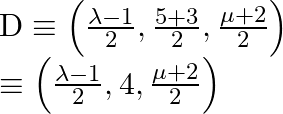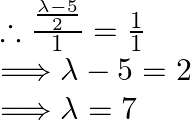Correct option is
(D) 7,10

Direction ratios of ![]() are
are ![]()
i.e. ![]()
i.e. ![]()
Since the line ![]() is equally inclined to coordinate axes, its direction ratios are in ratio
is equally inclined to coordinate axes, its direction ratios are in ratio ![]()

Also, 

Hence, the values of ![]() and
and ![]() are 7 and 10 respectively.
are 7 and 10 respectively.
Correct option is
(D) 7,10

Direction ratios of ![]() are
are ![]()
i.e. ![]()
i.e. ![]()
Since the line ![]() is equally inclined to coordinate axes, its direction ratios are in ratio
is equally inclined to coordinate axes, its direction ratios are in ratio ![]()

Also, 

Hence, the values of ![]() and
and ![]() are 7 and 10 respectively.
are 7 and 10 respectively.